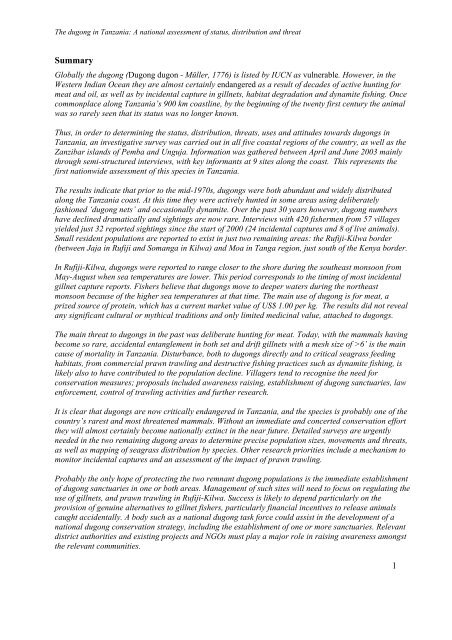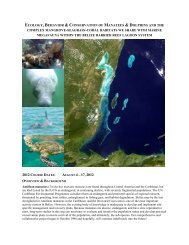Dugong dugon - Sirenian International
Dugong dugon - Sirenian International
Dugong dugon - Sirenian International
- No tags were found...
You also want an ePaper? Increase the reach of your titles
YUMPU automatically turns print PDFs into web optimized ePapers that Google loves.
The <strong>dugon</strong>g in Tanzania: A national assessment of status, distribution and threat<br />
Summary<br />
Globally the <strong>dugon</strong>g (<strong>Dugong</strong> <strong>dugon</strong> - Müller, 1776) is listed by IUCN as vulnerable. However, in the<br />
Western Indian Ocean they are almost certainly endangered as a result of decades of active hunting for<br />
meat and oil, as well as by incidental capture in gillnets, habitat degradation and dynamite fishing. Once<br />
commonplace along Tanzania’s 900 km coastline, by the beginning of the twenty first century the animal<br />
was so rarely seen that its status was no longer known.<br />
Thus, in order to determining the status, distribution, threats, uses and attitudes towards <strong>dugon</strong>gs in<br />
Tanzania, an investigative survey was carried out in all five coastal regions of the country, as well as the<br />
Zanzibar islands of Pemba and Unguja. Information was gathered between April and June 2003 mainly<br />
through semi-structured interviews, with key informants at 9 sites along the coast. This represents the<br />
first nationwide assessment of this species in Tanzania.<br />
The results indicate that prior to the mid-1970s, <strong>dugon</strong>gs were both abundant and widely distributed<br />
along the Tanzania coast. At this time they were actively hunted in some areas using deliberately<br />
fashioned ‘<strong>dugon</strong>g nets’ and occasionally dynamite. Over the past 30 years however, <strong>dugon</strong>g numbers<br />
have declined dramatically and sightings are now rare. Interviews with 420 fishermen from 57 villages<br />
yielded just 32 reported sightings since the start of 2000 (24 incidental captures and 8 of live animals).<br />
Small resident populations are reported to exist in just two remaining areas: the Rufiji-Kilwa border<br />
(between Jaja in Rufiji and Somanga in Kilwa) and Moa in Tanga region, just south of the Kenya border.<br />
In Rufiji-Kilwa, <strong>dugon</strong>gs were reported to range closer to the shore during the southeast monsoon from<br />
May-August when sea temperatures are lower. This period corresponds to the timing of most incidental<br />
gillnet capture reports. Fishers believe that <strong>dugon</strong>gs move to deeper waters during the northeast<br />
monsoon because of the higher sea temperatures at that time. The main use of <strong>dugon</strong>g is for meat, a<br />
prized source of protein, which has a current market value of US$ 1.00 per kg. The results did not reveal<br />
any significant cultural or mythical traditions and only limited medicinal value, attached to <strong>dugon</strong>gs.<br />
The main threat to <strong>dugon</strong>gs in the past was deliberate hunting for meat. Today, with the mammals having<br />
become so rare, accidental entanglement in both set and drift gillnets with a mesh size of >6’ is the main<br />
cause of mortality in Tanzania. Disturbance, both to <strong>dugon</strong>gs directly and to critical seagrass feeding<br />
habitats, from commercial prawn trawling and destructive fishing practices such as dynamite fishing, is<br />
likely also to have contributed to the population decline. Villagers tend to recognise the need for<br />
conservation measures; proposals included awareness raising, establishment of <strong>dugon</strong>g sanctuaries, law<br />
enforcement, control of trawling activities and further research.<br />
It is clear that <strong>dugon</strong>gs are now critically endangered in Tanzania, and the species is probably one of the<br />
country’s rarest and most threatened mammals. Without an immediate and concerted conservation effort<br />
they will almost certainly become nationally extinct in the near future. Detailed surveys are urgently<br />
needed in the two remaining <strong>dugon</strong>g areas to determine precise population sizes, movements and threats,<br />
as well as mapping of seagrass distribution by species. Other research priorities include a mechanism to<br />
monitor incidental captures and an assessment of the impact of prawn trawling.<br />
Probably the only hope of protecting the two remnant <strong>dugon</strong>g populations is the immediate establishment<br />
of <strong>dugon</strong>g sanctuaries in one or both areas. Management of such sites will need to focus on regulating the<br />
use of gillnets, and prawn trawling in Rufiji-Kilwa. Success is likely to depend particularly on the<br />
provision of genuine alternatives to gillnet fishers, particularly financial incentives to release animals<br />
caught accidentally. A body such as a national <strong>dugon</strong>g task force could assist in the development of a<br />
national <strong>dugon</strong>g conservation strategy, including the establishment of one or more sanctuaries. Relevant<br />
district authorities and existing projects and NGOs must play a major role in raising awareness amongst<br />
the relevant communities.<br />
1













